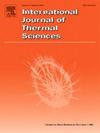Unlocking the potential of lauric acid: A promising solution for battery thermal management
IF 4.9
2区 工程技术
Q1 ENGINEERING, MECHANICAL
International Journal of Thermal Sciences
Pub Date : 2025-02-25
DOI:10.1016/j.ijthermalsci.2025.109822
引用次数: 0
Abstract
This paper presents a comprehensive experimental investigation into the thermal management of lithium-ion batteries using lauric acid as a phase change material (PCM). The study explores the effectiveness of lauric acid under various design and operating conditions, including different battery pack voltages (12V, 24V, 48V), cell spacing (0.25D, 0.5D, and 1D – D: diameter of battery), discharge rates (1C, 2C, 3C, 4C, and 5C), and the incorporation of active air cooling that uses varying external air velocities (5, 7.5, and 10 m/s). The results demonstrate that the hybrid cooling system can maintain the desired temperature, which is below the melting point of lauric acid (43–45 °C). The hybrid cooling system has successfully reduced the temperature differences within the battery pack, consistently maintaining them below 5 °C. The energy efficiencies exceeded 80 % and approached 90 % in most cases. These observations indicate the capability of lauric acid to maintain battery temperatures within safe operating limits, reduce temperature differences within the pack, and achieve high energy efficiency. This research highlights the potential of lauric acid as a promising, cost-effective, and safe PCM solution for battery thermal management systems, particularly in long-term applications.
本文对使用月桂酸作为相变材料 (PCM) 的锂离子电池热管理进行了全面的实验研究。研究探讨了月桂酸在各种设计和操作条件下的有效性,包括不同的电池组电压(12V、24V 和 48V)、电池间距(0.25D、0.5D 和 1D - D:电池直径)、放电速率(1C、2C、3C、4C 和 5C),以及使用不同外部空气速度(5、7.5 和 10 米/秒)的主动空气冷却。结果表明,混合冷却系统可以保持理想的温度,即低于月桂酸的熔点(43-45 °C)。混合冷却系统成功地降低了电池组内的温差,使其始终保持在 5 °C 以下。能量效率超过 80%,在大多数情况下接近 90%。这些观察结果表明,月桂酸有能力将电池温度保持在安全操作范围内,减少电池组内的温差,并实现高能效。这项研究凸显了月桂酸作为电池热管理系统中一种前景广阔、经济高效且安全的 PCM 解决方案的潜力,尤其是在长期应用中。
本文章由计算机程序翻译,如有差异,请以英文原文为准。
求助全文
约1分钟内获得全文
求助全文
来源期刊

International Journal of Thermal Sciences
工程技术-工程:机械
CiteScore
8.10
自引率
11.10%
发文量
531
审稿时长
55 days
期刊介绍:
The International Journal of Thermal Sciences is a journal devoted to the publication of fundamental studies on the physics of transfer processes in general, with an emphasis on thermal aspects and also applied research on various processes, energy systems and the environment. Articles are published in English and French, and are subject to peer review.
The fundamental subjects considered within the scope of the journal are:
* Heat and relevant mass transfer at all scales (nano, micro and macro) and in all types of material (heterogeneous, composites, biological,...) and fluid flow
* Forced, natural or mixed convection in reactive or non-reactive media
* Single or multi–phase fluid flow with or without phase change
* Near–and far–field radiative heat transfer
* Combined modes of heat transfer in complex systems (for example, plasmas, biological, geological,...)
* Multiscale modelling
The applied research topics include:
* Heat exchangers, heat pipes, cooling processes
* Transport phenomena taking place in industrial processes (chemical, food and agricultural, metallurgical, space and aeronautical, automobile industries)
* Nano–and micro–technology for energy, space, biosystems and devices
* Heat transport analysis in advanced systems
* Impact of energy–related processes on environment, and emerging energy systems
The study of thermophysical properties of materials and fluids, thermal measurement techniques, inverse methods, and the developments of experimental methods are within the scope of the International Journal of Thermal Sciences which also covers the modelling, and numerical methods applied to thermal transfer.
 求助内容:
求助内容: 应助结果提醒方式:
应助结果提醒方式:


